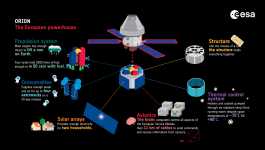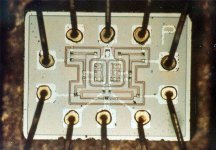Report from Reuters:
Re-entry marked the single most critical phase of Orion's journey, testing whether its newly designed heat shield can withstand atmospheric friction and safely protect astronauts that would be on board.
"It is our priority-one objective," NASA's Artemis I mission manager Mike Sarafin said at a briefing last week. "There is no arc-jet or aerothermal facility here on Earth capable of replicating hypersonic re-entry with a heat shield of this size."
Watched the live stream. Kept getting booted off and had to constantly reinitialize the stream. Annoying but worth it. Congrats to NASA and all others involved! What was most impressive was the skip re-entry. Anyone old enough to remember the Apollo missions will recall the fear of bouncing off the atmosphere. Now they're doing it on purpose! Rubber dingy at the scene in barely 6mins. Impressive! Did any part of the entire mission not go exactly as planned?
Member
Joined 2009
Paid Member
I was gripped by the whole thing! A 2 hour introduction to some of the intricasies of Spaceflight! NASA's channel is full of interest, as it goes.
https://www.nasa.gov/multimedia/nasatv/index.html#public
NASA landed that thing on a postage stamp! The onboard camera was good too. You could see the horizon getting flatter as it came down.
Even at Mach 2 atmospheric heating was a problem on Concord aeroplane IIRC.
I saw a dinghy near the capsule after about 4 minutes, but the commentator didn't mention it, concentrting on the helicopters.
I think they stress tested the capsule at 23,000 mph and 5,000F temperature re-entry. Apollo was 17,000 mph.
It becomes clear that Artemis 1 was far quicker than what is needed for a Moon landing. It merely grazed the Moon rather than orbited it:

Something I found interesting is that Orion had to shed all the kinetic and gravity potential energy it had acquired on the way up from the huge rockets by friction on re-entry. The cold hard equations.
Incredible technology and accurate calculations.

11 Dec 2022 Artemis 1 splashdown was exactly 50 years after Apollo 17 landed on the Moon on 11 Dec 1972! Spooky, eh? 😀
https://www.nasa.gov/multimedia/nasatv/index.html#public
NASA landed that thing on a postage stamp! The onboard camera was good too. You could see the horizon getting flatter as it came down.
Even at Mach 2 atmospheric heating was a problem on Concord aeroplane IIRC.
I saw a dinghy near the capsule after about 4 minutes, but the commentator didn't mention it, concentrting on the helicopters.
I think they stress tested the capsule at 23,000 mph and 5,000F temperature re-entry. Apollo was 17,000 mph.
It becomes clear that Artemis 1 was far quicker than what is needed for a Moon landing. It merely grazed the Moon rather than orbited it:
Something I found interesting is that Orion had to shed all the kinetic and gravity potential energy it had acquired on the way up from the huge rockets by friction on re-entry. The cold hard equations.
Incredible technology and accurate calculations.
11 Dec 2022 Artemis 1 splashdown was exactly 50 years after Apollo 17 landed on the Moon on 11 Dec 1972! Spooky, eh? 😀
Last edited:
Yes, the calculations were as accurate as they were fifty years ago when the astronauts didn't have much more than a slide rule and a HP pocket calculator, and the complete NASA computer equipment wasn't as powerful as a today's middle class smartphone. Incredible, eh?
Best regards!
Best regards!
Where can we get that particular information from? I find that makes very little sense.... the calculations were as accurate as they were fifty years ago...
Just because I don't see too much differences between the moon missions from 1968 to 1972 and the Artemis mission. 50 and more years ago they already managed to bring something (and even someone!) to the moon and back, which nowadays appears to be almost incredible w.r.t. the technology NASA had in those days.
Best regards!
Best regards!
The European Service Module, as well as providing the propulsion and advanced avionics for the Orion spacecraft, will also provide the air for future astronauts to breathe.
The breathable air will be produced by mixing oxygen and nitrogen together.
The oxygen portion of the life support system was not tested during the Artemis I mission, although the nitrogen delivery system was.
Luckily, the dummy astronauts aboard Orion didn't mind the lack of oxygen, any more than did the Zero-G indicators, Snoopy and Shaun!
NASA says that it plans to properly test the life support systems closer to the launch of the second Artemis mission.
The breathable air will be produced by mixing oxygen and nitrogen together.
The oxygen portion of the life support system was not tested during the Artemis I mission, although the nitrogen delivery system was.
Luckily, the dummy astronauts aboard Orion didn't mind the lack of oxygen, any more than did the Zero-G indicators, Snoopy and Shaun!
NASA says that it plans to properly test the life support systems closer to the launch of the second Artemis mission.
Attachments
Member
Joined 2009
Paid Member
I believe at the time of the Apollo 11 moon landing that the computing power they had was centred around the IBM 360. This was a breakthrough in main frame computing technology in 1964 when discrete germanium transistors used in the IBM 1401 series were replaced with micro-electronics. Small ceramic tiles were made with tiny chips of transistors robotically placed onto metal traces and sealed under a cap. Not yet the integrated circuit but darn close. The Apollo on-board computer was another miracle of engineering and I read somewhere that it used up 70% of the worlds production of what was then state of art semiconductor integration technology to build something that was years ahead of it's time - something like a 1980 consumer computer but available in the late 1960's.
Oh yea, I remember my friend Bill showing me a marvel he produced in his "programming" class at that time..1980 to be exact. It consisted of a crude silohette picture of an animal made up of 1s and 0s. He was amazed, I was embarrassed for him at which he proclaimed the technology had "come a long way".
...I'm sure it had.
...I'm sure it had.
"Computers in Spaceflight - The NASA Experience": https://www.hq.nasa.gov/office/pao/History/computers/Computing.html
"The Apollo guidance computer: Hardware": https://www.hq.nasa.gov/office/pao/History/computers/Ch2-5.html
Loads of geeky space computer stuff on that site! Here's the index page: https://www.hq.nasa.gov/office/pao/History/computers/Part1.html
🤓
"The Apollo guidance computer: Hardware": https://www.hq.nasa.gov/office/pao/History/computers/Ch2-5.html
Loads of geeky space computer stuff on that site! Here's the index page: https://www.hq.nasa.gov/office/pao/History/computers/Part1.html
🤓
The Apollo on-board computer was another miracle of engineering...
Wikipedia gives more details and photographs: https://en.wikipedia.org/wiki/Apollo_Guidance_Computer
Attachments
Member
Joined 2009
Paid Member
Back at that time, such advanced technology was not in the public domain, everyone was using pencil and paper. Only NASA had the kind of 'pull' to do what they did at that time. Even a photo like that Dual NOR gate chip would have been something special to the public unused to seeing anything like it. Nowadays, movies and other media are full of images of chips, pcb's, fantastic 3d computer generated images of fantastical technology etc.
So hardware technology has become commonplace, commoditized to the point where nobody asks what it is, how it works etc. Advances seem more obvious in areas of software such as AI / machine learning - all supported by that now almost invisible layer of hardware technology that still advances every year.
So hardware technology has become commonplace, commoditized to the point where nobody asks what it is, how it works etc. Advances seem more obvious in areas of software such as AI / machine learning - all supported by that now almost invisible layer of hardware technology that still advances every year.
- Home
- Member Areas
- The Lounge
- Artemis - the NASA mission


